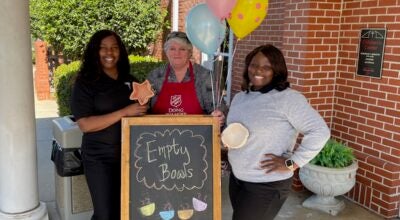A stich in history
Published 7:37 pm Saturday, January 24, 2009
Susan Berry and Joyce Conrad sat transfixed before a wall of colorful quilts and marveled at the stories that unfolded before them.
“Amazing,” Berry said. “It’s amazing what we can learn about our past from something as simple as a quilt.”
The ladies laughed because in reality there is nothing “simple” about a quilt, at least, for those involved in the process. Quilting is a tedious and time-consuming task and one that is not easily mastered without a love of the art and a bushel of patience.
Berry and Conrad know that, as do others who have tried their hand at quilting. They also have a deep appreciation for the American art form.
“Quilts have a place in Southern culture and are part of many family traditions,” Conrad said. “Quilts are treasured items that are passed down from generation to generation.”
And Berry quickly added that it’s the character of a quilt, not it’s construction, that makes it a treasure.
“Many of our heirloom quilts are crudely done but so cherished because they were done by those who are the people that we came from,” she said.
Berry and Conrad are among the docents who will lead tours of the “Just How I Pictured It in My Mind” quilt exhibition at the Johnson Center for the Arts in Troy through March 27.
The exhibit is on loan from the Montgomery Museum of Fine Arts.
Stories are wrapped in the colors and patterns of each of the 16 African American quilts chosen for this exhibit and the stories are as fascinating and as endearing as the quilts themselves, said Wiley White, development director of Troy-Pike Cultural Arts Center.
“There’s a story or purpose behind each of these quilts and that makes them even more intriguing,” she said.
Yvonne Wells said of her quilt, “the Higginbothams, “This is David and Lois Higginbotham and they just wanted to say ‘Hello’ to you. Mrs. Higginbotham has on a matching purse and shoes that also match the buttons on her dress. She is wearing a very stunning hat with golden earbobs.”
Simple and simply charming.
Wells’ “Shout! Hallelujah” illustrates her ability to convey a jubilant spirit and “Descending Dove” illustrates her reflective spiritual nature.
Wells’ “Yesterday: Civil Rights in the South” is a story quilt that traces the path of the Civil Rights movement. The symbols depict Rosa Parks’ historical bus ride, the presence of the Ku Klux Klan, segregated water fountains, the bombing of the church in Birmingham that killed four little girls and other events in the movement.
Maggie Smith’s used the “Pig Pen” pattern for her string quilt. Mary Lucas and Addie Pelt’s “Everybody” quilts combine color and patterns to create quilts that are visually exciting and illusional.
The American Flag Blocks quilt seems to quiz viewers as to which row of flags is unlike the others. Then views are left to wonder why.
Quilts sometimes tell stories but more often they are sources of physical comfort or visual stimulation.
However, during the Civil War, they marked a path to freedom for many runaway slaves, Berry said.
“As slaves made the dangerous journey to Canada and to freedom, they were helped along the way by those who sympathized with their plight,” Berry said. “You can imagine how difficult it must have been for them. They had never been away from the plantations so they knew nothing about the countryside or where to go but a path was made for them and quilts marked the way.”
Berry said there was nothing unusual about quilts airing on a clothesline or across a porch railing.
“Both the quilt patterns and the way the quilt was hanging gave slaves directions to ‘the Promised Land,’” she said. “A quilt with the geese pattern was folded so that it pointed the direction they were to go.”
The hammer pattern alerted the slaves to collect the tools of their trade for their impending journey. The bowtie pattern let them know when they were to take off their traveling clothes and put on the clothes that were provided for them.
“It’s amazing that quilts were used to guide slaves to freedom,” Berry said. “Something as simple as a quilt did so much. The star pattern was used to signal the runaway slaves that they had reached Canada. Otherwise they had no idea where they were but once they saw a quilt with a star, they knew they were free.”
White said the “Just How I Pictured It in My Mind” exhibition is an outstanding display of quilt culture and a stimulus for storytelling.
“The docents will have interesting facts about the art of quilting as well as stories to share with visitors,” she said. “Quilters will be at the Center on certain days working on a quilt with the double wedding band pattern. They will be available to answer questions about the construction of quilts. They are also knowledgeable about quilt patterns and their history. The quilt exhibition is one that will be enjoyed by all ages.”
While at the Johnson Center for the Arts, visitors will also enjoy the “People’s Lives: A Photographic Celebration Human Spirit” by Bill Wright.
The exhibit features 60 photographs taken around the world by the noted Texas photographer. The images take viewers inside the homes, businesses and schools of everyday people and reveal the positive aspects of their lives through the rich tapestries of their cultures, White said.
The Johnson Center for the Arts is open from 10 a.m. until 5 p.m. Tuesday through Saturday and from 1 until 5 p.m. on Sunday. Admission is always free.
The current exhibitions are made possible in part by grants from the Alabama State Council on the Arts and the National Endowment for the Arts.



